August 23, 2021 11:46 AM
These are the approximate positions of the U.S. Navy’s deployed carrier strike groups and amphibious ready groups throughout the world as of Aug. 23, 2021, based on Navy and public data. In cases where a CSG or ARG is conducting disaggregated operations, the chart reflects the location of the capital ship.
Total U.S. Navy Battle Force:
296
Ships Underway
| Deployed Ships Underway | Non-deployed Ships Underway | Total Ships Underway |
| 70 | 18 | 88 |
Ships Deployed by Fleet
| Fleet Forces | 3rd Fleet | 4th Fleet | 5th Fleet | 6th Fleet | 7th Fleet | Total |
| 2 | 5 | 3 | 21 | 15 | 65 | 111 |
In the North Arabian Sea

An EA-18G Growler electronic attack aircraft, attached to the ‘Shadowhawks’ of Electronic Attack Squadron (VAQ) 141, prepares to launch from the flight deck of aircraft carrier USS Ronald Reagan (CVN-76) in the Arabian Sea on Aug. 21, 2021. US Navy Photo
The Ronald Reagan Carrier Strike Group is in the North Arabian Sea. USS Ronald Reagan (CVN-76), guided-missile cruiser USS Shiloh (CG-67) and guided-missile destroyer USS Halsey (DDG-97) arrived in U.S. 5th Fleet on June 25.
The carrier is in position in the North Arabian Sea to support Afghanistan operations. When aircraft launch from the carrier in the North Arabian Sea they conduct an air-to-air refuel while flying north through Pakistan airspace, tank again over Afghanistan, and tank again on return before recovering onboard the carrier. These are long sorties into a landlocked country – over 400 miles inland. “F-18s from the Ronald Reagan Carrier Strike Group flew armed overwatch flights over Kabul to ensure enhanced security,” Army Maj. Gen. Hank Taylor, deputy director of Joint Staff Regional Operations, told reporters on Thursday morning.
Aircraft carrier

Information Systems Technician 2nd Class Victoria Leoni patches cables aboard aircraft carrier USS Ronald Reagan (CVN-76) in the Arabian Sea on Aug. 21, 2021. US Navy Photo
USS Ronald Reagan (CVN-76), homeported in Yokosuka, Japan.
Carrier Air Wing 5
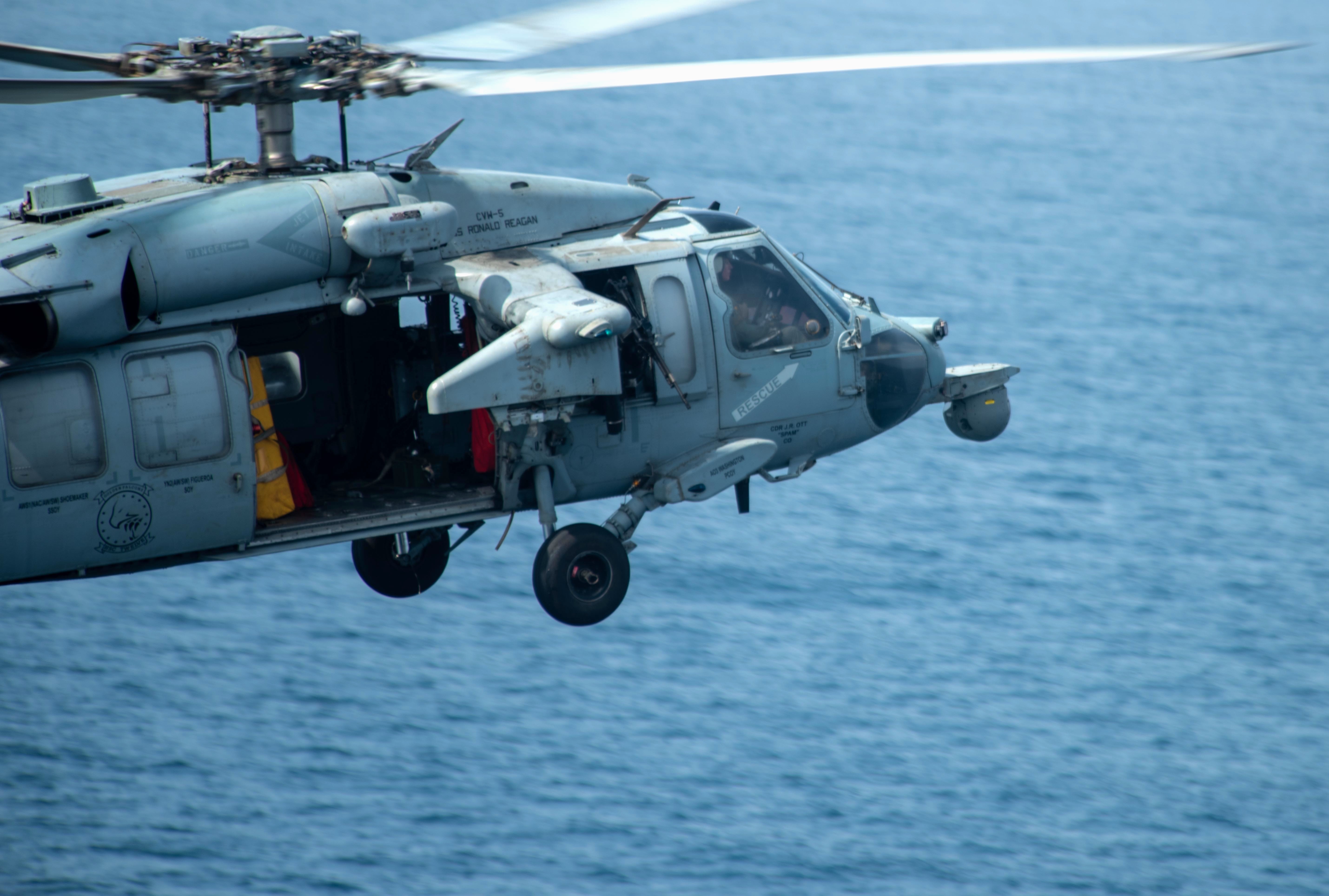
An MH-60S Knight Hawk helicopter, attached to the ‘Golden Falcons’ of Helicopter Sea Combat Squadron (HSC) 12, lands on the flight deck of aircraft carrier USS Ronald Reagan (CVN-76), not pictured, in the Arabian Sea on Aug. 22, 2021. US Navy Photo
Carrier Air Wing (CVW) 5, based at Marine Corps Air Station Iwakuni, Japan, is embarked aboard Ronald Reagan and includes a total of nine squadrons and detachments:
- The “Royal Maces” of VFA-27 – Strike Fighter Squadron (VFA) – from Marine Corps Air Station Iwakuni
- The “Diamondbacks” of VFA-102 from Marine Corps Air Station Iwakuni
- The “Eagles” of VFA-115 from Marine Corps Air Station Iwakuni
- The “Dambusters” of VFA-195 from Marine Corps Air Station Iwakuni
- The “Shadowhawks” of VAQ-141 – Electronic Attack Squadron (VAQ) – from Marine Corps Air Station Iwakuni
- The “Tigertails” of VAW-125 – Carrier Airborne Early Warning Squadron (VAW) – from Marine Corps Air Station Iwakuni
- The “Providers” of VRC-30 – Detachment 5 – Fleet Logistics Support Squadron (VRC) – from Marine Corps Air Station Iwakuni
- The “Golden Falcons” of HSC-12 – Helicopter Sea Combat Squadron (HSC) – from Naval Facility Atsugi, Japan
- The “Saberhawks” of HSM-77 – Helicopter Maritime Strike Squadron (HSM) – from Naval Air Facility Atsugi, Japan
Cruiser
USS Shiloh (CG-67), homeported in Yokosuka.
Destroyer Squadron 15
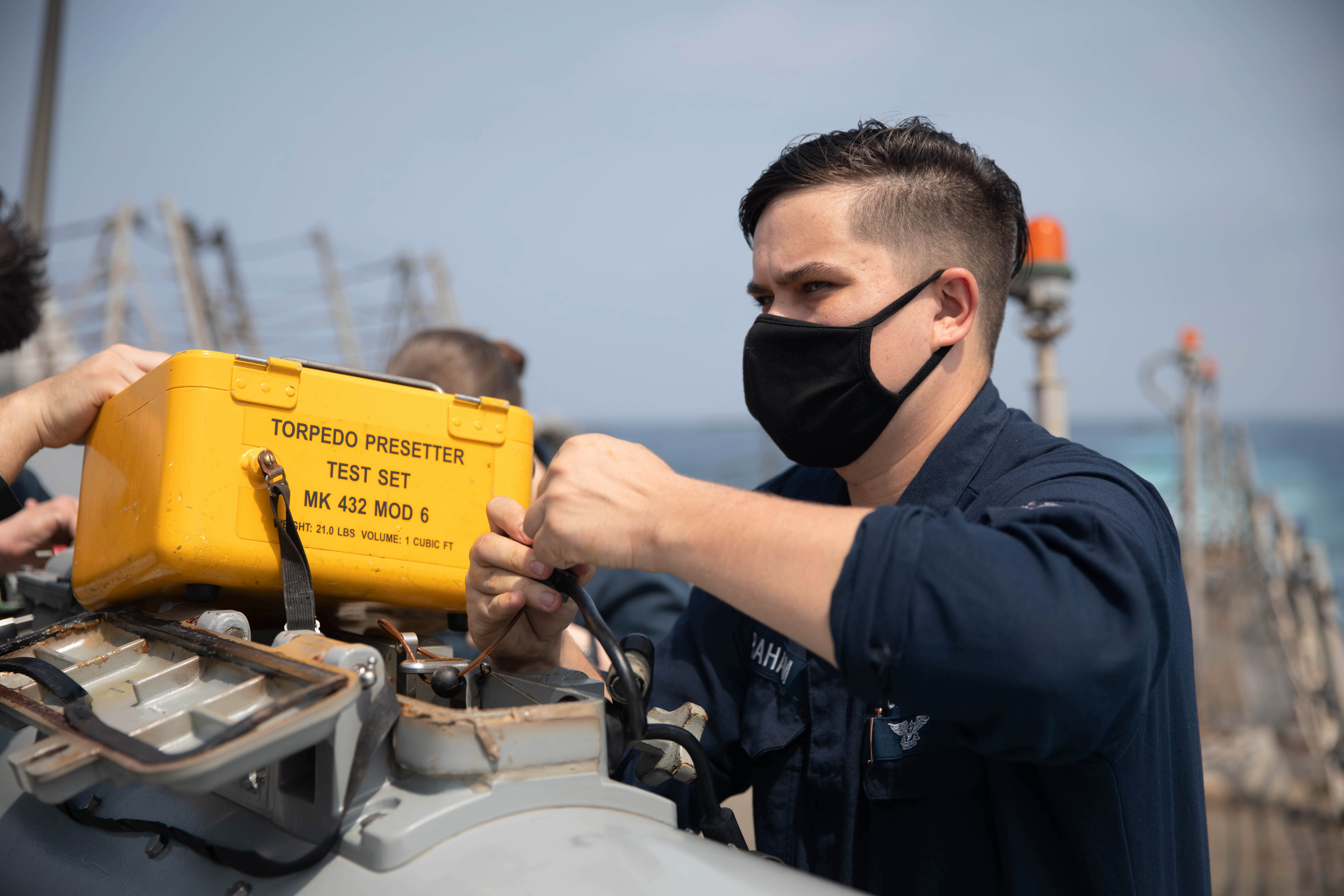
Sonar Technician 2nd Class Brennan Graham prepares to launch air slugs from a torpedo tube on the guided-missile destroyer USS Halsey (DDG-97) in the Arabian Sea on Aug. 12, 2021. US Navy Photo
Destroyer Squadron 15 is based in Yokosuka, Japan, and is embarked on the carrier. U.S. 7th Fleet has not fully specified the escorts accompanying Reagan on its patrol, but the CSG includes:
- USS Halsey (DDG-97), homeported in Pearl Harbor, Hawaii.
In the Persian Gulf
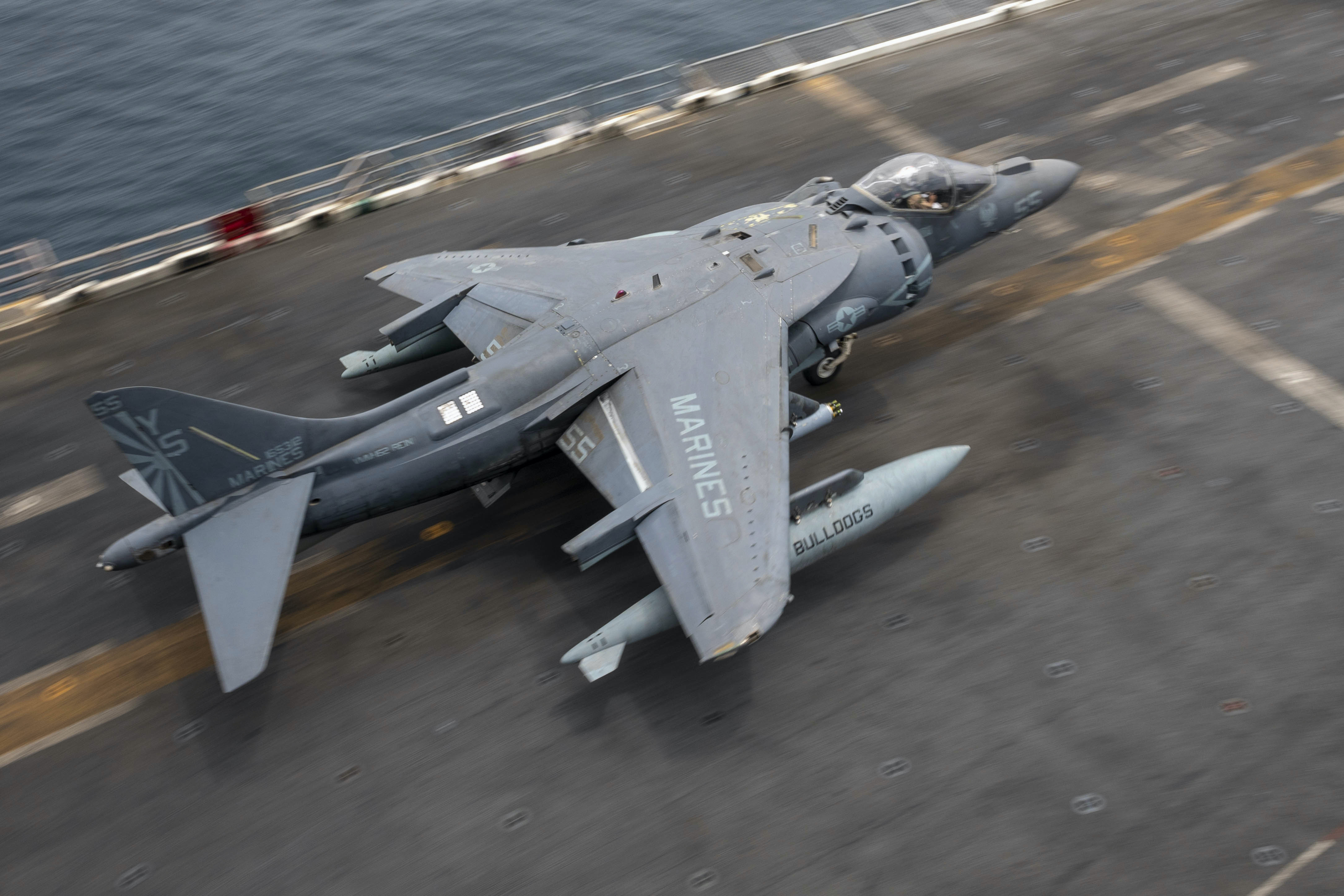
An AV-8B Harrier, attached to Marine Medium Tiltrotor Squadron (VMM) 162 (Reinforced), takes off from the flight deck of the Wasp-class amphibious assault ship USS Iwo Jima (LHD-7) on Aug. 17, 2021. US Navy Photo
The Iwo Jima Amphibious Ready Group and the 24th Marine Expeditionary Unit (MEU) are now back in the Persian Gulf. This places the ARG-MEU in position to provide additional reinforcement of the Marine Corps Special Purpose Marine Air-Ground Task Force – Contingency Response – in Kuwait. Most of the 24th MEU’s battalion landing team and combat logistical battalion are already ashore, but the bulk aviation units have remained on the ships. Brig. Gen. Peter Huntley, director of operations at Marine Corps headquarters, told reporters during a media call Thursday afternoon that the Marines “also are participating as part of the perimeter security” at the airport, a mission led by the Army’s 82nd Airborne Division.
As of Saturday, there are 5,800 U.S. troops in Kabul as part of the unnamed non-combatant evacuation operation that was put into effect, Pentagon officials said on Monday.
“They are being commanded and controlled by Joint Task Force-Crisis Response, which I based around Task Force 515,” Huntley said. TF-515, which falls under Marine Corps Forces Central Command, is a headquarters unit based in Bahrain.
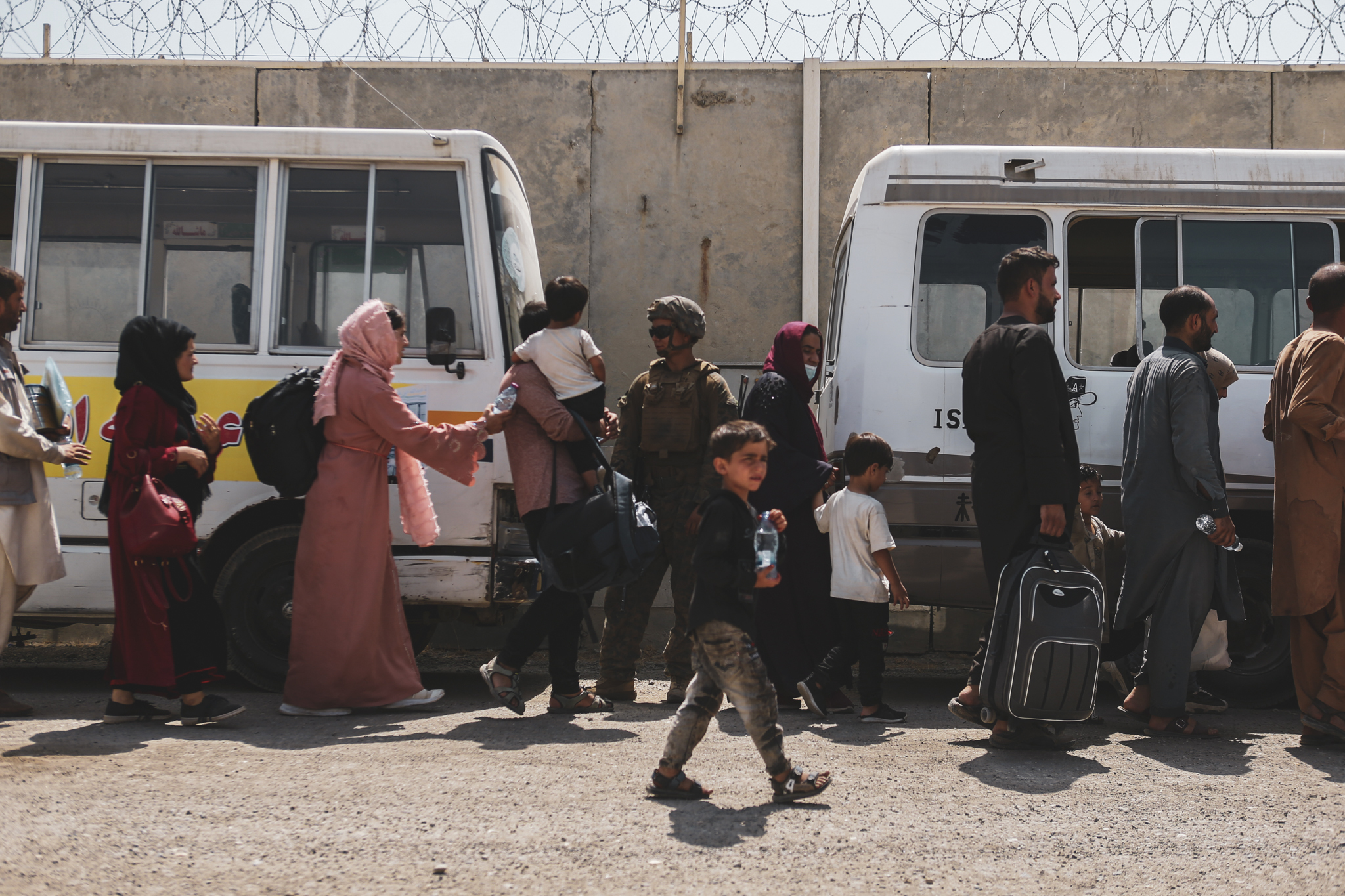
Evacuees load on to buses to be processed during an evacuation at Hamid Karzai International Airport, Kabul, Afghanistan on Aug. 22, 2021. US Marine Corps Photo
Fifty Marines with the SPMAGTF-CR-CC established command and control as the backbone for forces at the airport in Kabul. About 1,200 from 1st Battalion, 8th Marines and Combat Logistics Battalion 24 from Camp Lejeune, N.C., deployed from the Iwo Jima ARG for Kabul. They were followed by Marines and sailors with 2nd Batallion, 1st Marines and elements of Combat Logistics Regiment 1 based at Camp Pendleton, Calif., bringing the total number of Marines from the SPMAGTF ashore in Afghanistan to about 800.
Marines arrived in Kabul with “multiple days of supplies on their backs,” including supplies, food, water and ammunition and are “living expeditionary,” Huntley said. “They train to that, so it’s to be expected.” The majority of the 24th MEU’s battalion landing team and combat logistical battalion are ashore.”
“On the ground, it was very challenging,” said Huntley, an infantry officer whose experience includes multiple tours in Afghanistan and in Iraq. “There was a relatively small number of Marines … but they were able to reestablish the perimeter at the airport, and they were able to get the airfield cleared, which enabled that evening for additional forces to flow in” from the SPMAGTF and 82nd Airborne.
The 24th MEU, specifically within its combat logistics battalion, is equipped and prepared to provide front-line medical, surgical and trauma care, and most of those capabilities are now on the ground in Afghanistan, officials said.
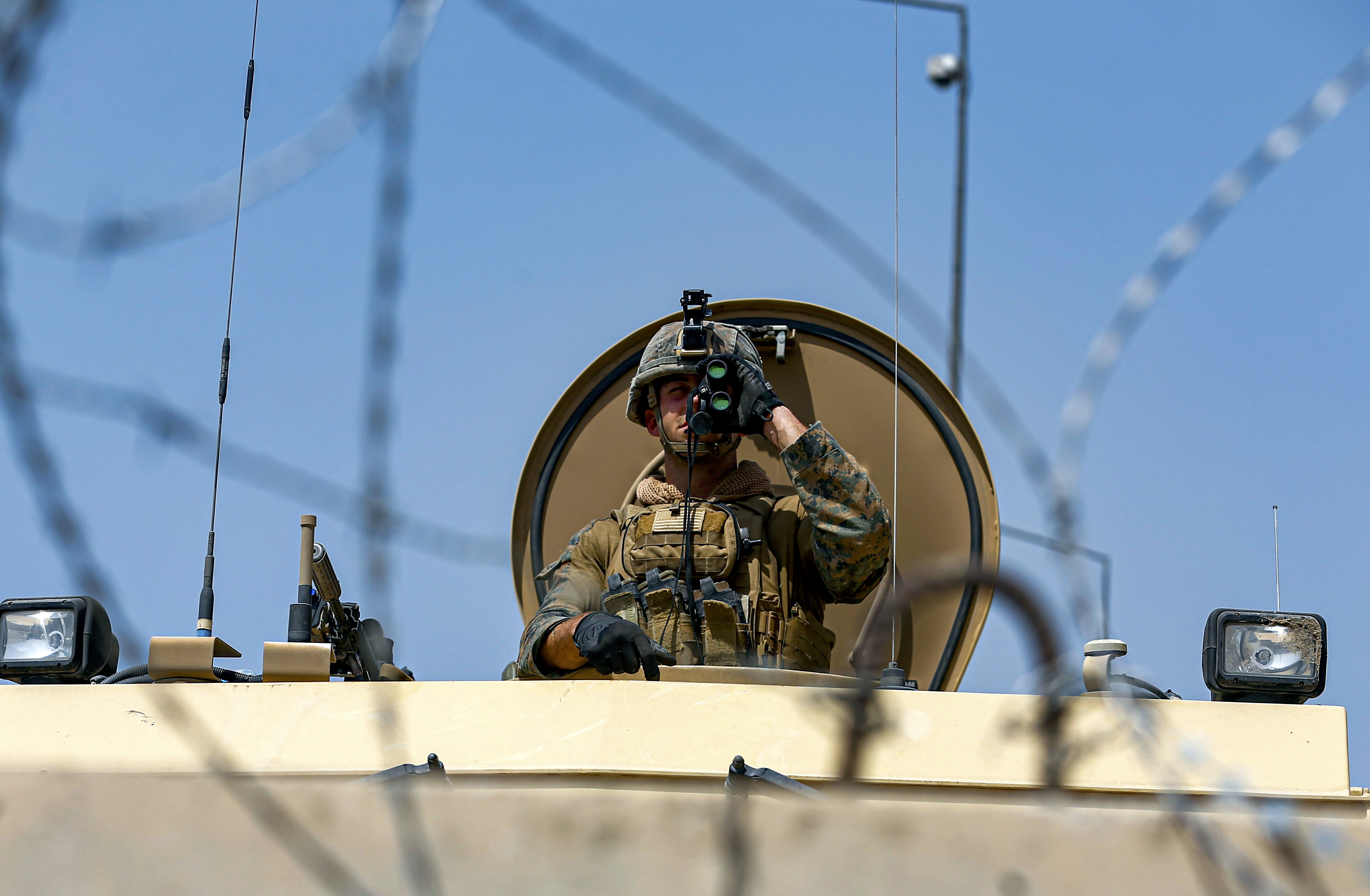
A Marine assigned to 24th Marine Expeditionary Unit (MEU) provides over-watch during an evacuation at Hamid Karzai International Airport, Kabul, Afghanistan on Aug. 21, 2021. US Marine Corps Photo
“There is a pretty strong capability … of providing that combat stabilization if a Marine or soldier or anybody else is seriously hurt. But they are helping, they are finding individuals who are coming through who need some form of medical help, and they’re aiding in that,” Huntley said. “The Marine elements that are on the ground have brought ashore their organic medical capabilities, which are pretty significant actually and of course they are expeditionary in nature so they’re living just like the Marines are.”
Those medical teams can stabilize serious injuries and prepare patients for medical evacuation to higher-level care and “in extremis case, they could do surgery if required,” he said.
The MEU’s KC-130J has been instrumental in bringing additional military personnel into Afghanistan to free up capacity for Air Force C-17 Globemasters to evacuate people from the airport. The MEU’s AV-8B Harriers are also part of the air operations over Afghanistan.
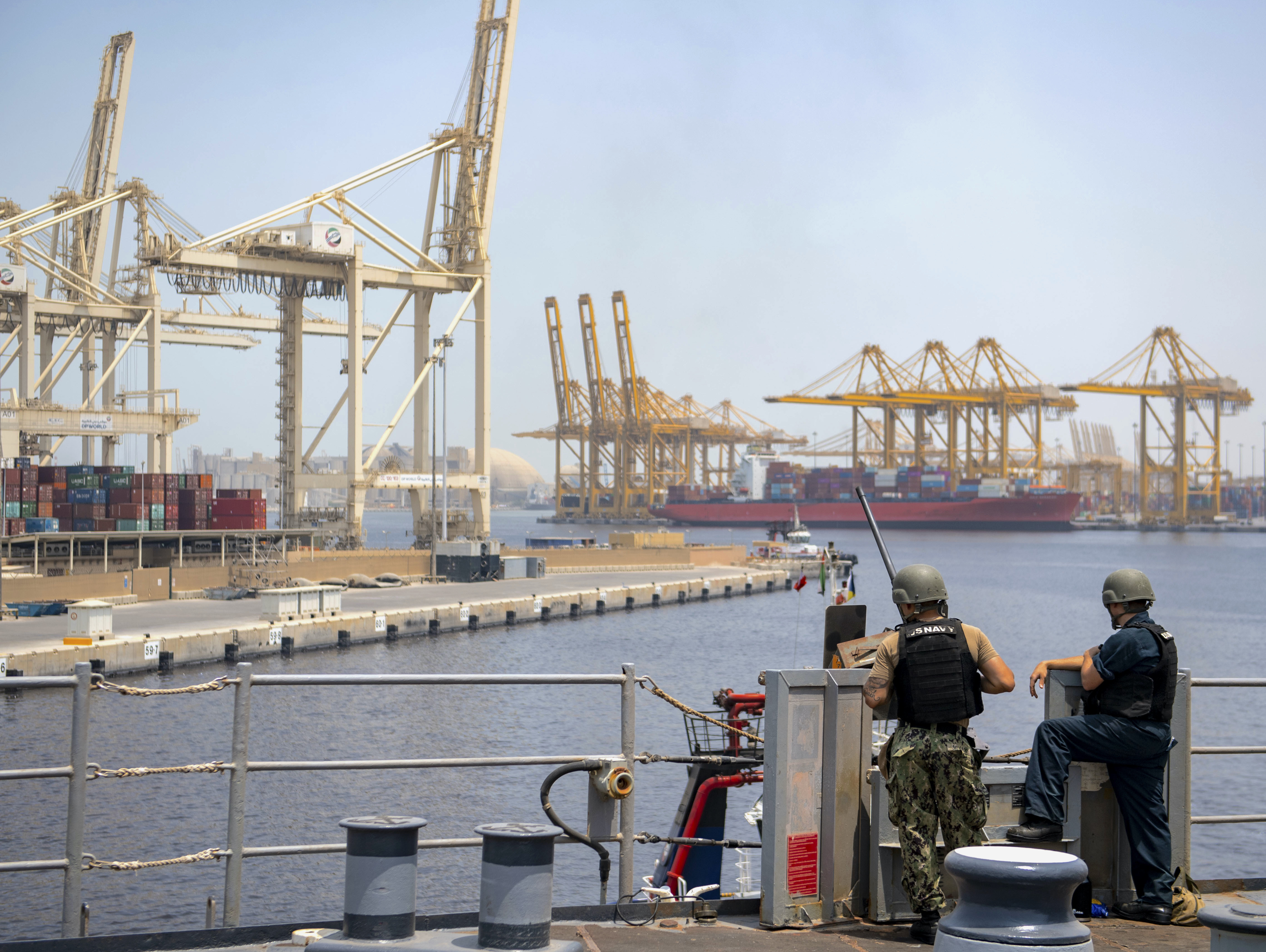
Retail Specialist Seaman Jeffrey Salgado, left, and Fire Controlman 2nd Class Preston Short, both assigned to the Harpers Ferry-class dock landing ship USS Carter Hall (LSD-50), man an M2HB .50 caliber machine gun during a sea and anchor evolution on Aug. 18, 2021. US Navy Photo
Wasp-class amphibious assault ship USS Iwo Jima (LHD-7), Harpers Ferry-class dock landing ship USS Carter Hall (LSD-50) and amphibious transport dock USS San Antonio (LPD-17) make up the ARG. Embarked detachments for the Iwo Jima ARG include Amphibious Squadron Four, Fleet Surgical Team (FST) Six, Helicopter Sea Combat Squadron (HSC) 26, Tactical Air Control Squadron (TACRON) 21, Naval Beach Group (NBG) Two, Beach Master Unit (BMU) Two, Assault Craft Unit (ACU) Two and Four, and Sailors from Amphibious Construction Battalion (ACB) Two.
The 24th MEU, which is headquartered at Marine Corps Base Camp Lejeune, N.C., consists of a Ground Combat Element, Battalion Landing Team (BLT) 1/8, a Logistics Combat Element, Combat Logistics Battalion (CLB) 24, and an Aviation Combat Element, Medium Tilt-Rotor Squadron (VMM) 162 Reinforced. The 24th MEU also includes a Light Armored Reconnaissance detachment.
In the Western Pacific
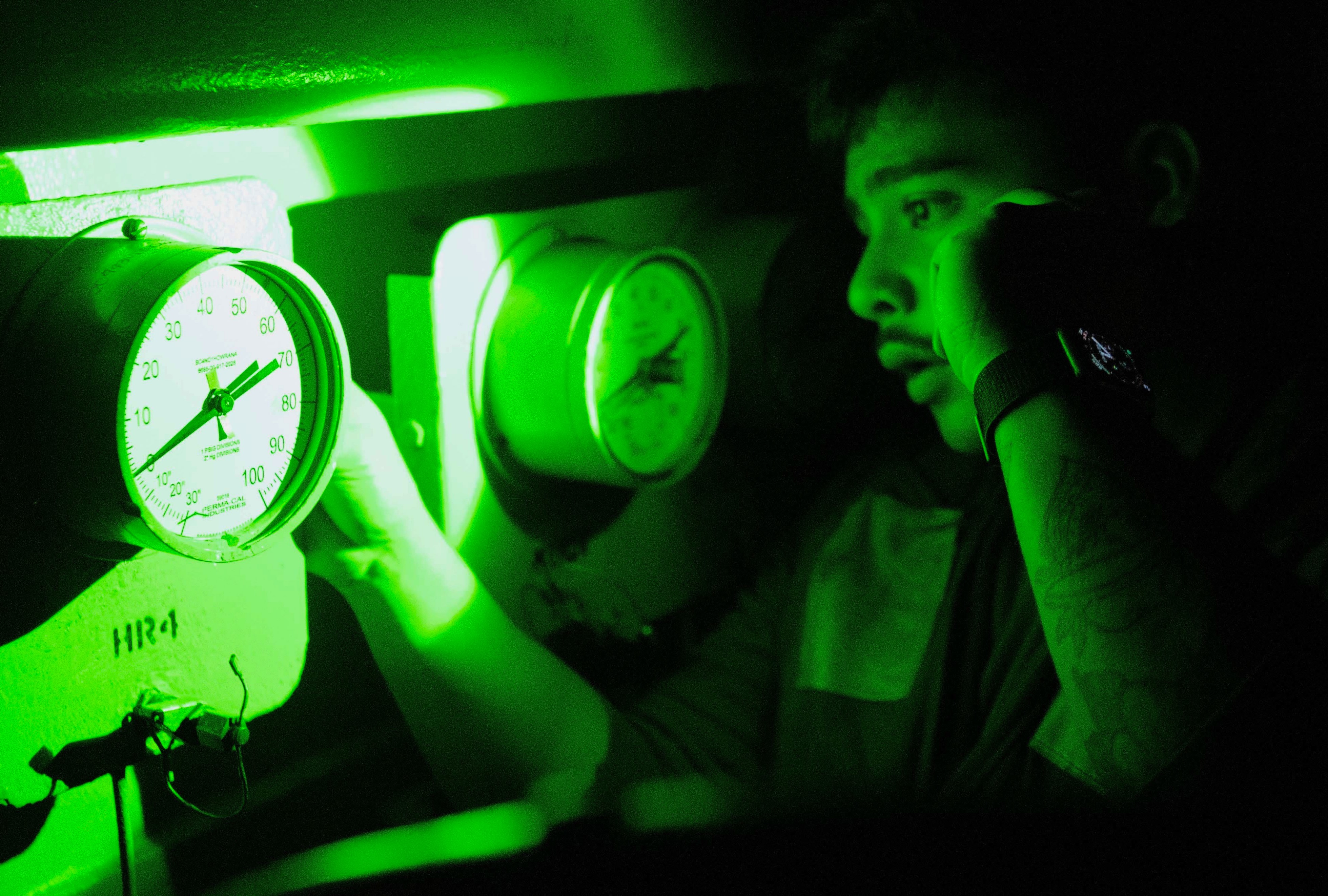
Aviation Boatswain’s Mate (Fuels) 3rd Class Raul Santoyo, a native of Houston, inspects a pressure gauge on the flight deck aboard Nimitz-class aircraft carrier USS Carl Vinson (CVN-70) on Aug. 20, 2021. US Navy Photo
The Carl Vinson Carrier Strike Group deployed on Aug. 2 and is in the Western Pacific operating in U.S. 7th Fleet. This is the first U.S. Navy deployment of F-35C Lightning II Joint Strike Fighters and the Navy’s new CMV-22B carrier onboard delivery aircraft.
Aircraft carrier
USS Carl Vinson (CVN-70), homeported in San Diego, Calif.
Carrier Air Wing 2
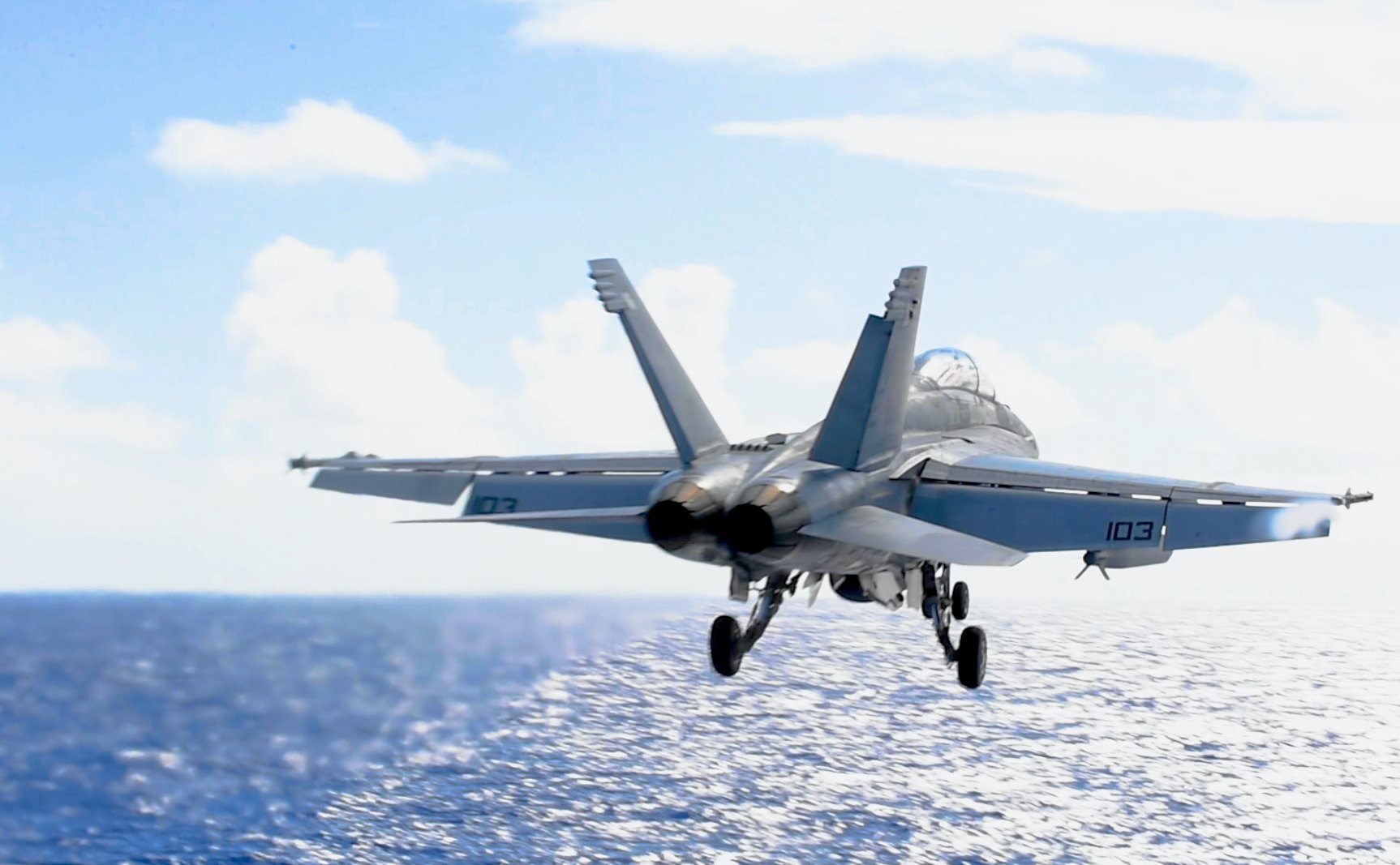
An F/A-18F Super Hornet, assigned to the ‘Bounty Hunters’ of Strike Fighter Squadron (VFA) 2, launches from the flight deck of Nimitz-class aircraft carrier USS Carl Vinson (CVN-70) to participate in a sinking exercise, Aug. 15, 2021. US Navy Photo
Carrier Air Wing (CVW) 2, based at Naval Air Station Lemoore, Calif., is embarked aboard Carl Vinson and includes a total of nine squadrons and detachments:
- The “Argonauts” of VFA-147 Strike Fighter Squadron (VFA) flying F-35Cs from Naval Air Station Lemoore, Calif.
- The “Bounty Hunters” of VFA-2 – F/A-18F – from Naval Air Station Lemoore.
- The “Stingers” of VFA-113 – F/A-18E – from Naval Air Station Lemoore.
- The “Golden Dragons” of VFA-192 – F/A-18E – from Naval Air Station Lemoore.
- The “Gauntlets” of VAQ-136 – EA-18G – Electronic Attack Squadron (VAQ) – from Naval Air Station Whidbey Island, Wash.
- The “Black Eagles” of VAW-113 – E-2D — Carrier Airborne Early Warning Squadron (VAW) – from Naval Air Station Point Mugu, Calif.
- The “Titans” of VRM-30 – CMV-22B – Fleet Logistics Multi-Mission Squadron (VRM) – from Naval Air Station North Island, Calif.
- The “Black Knights” of HSC-4 – MH-60S – Helicopter Sea Combat Squadron (HSC) – from Naval Air Station North Island.
- The “Blue Hawks” of HSM-78 – MH-60R – Helicopter Maritime Strike Squadron (HSM) – from Naval Air Station North Island.
Cruiser
USS Lake Champlain (CG-57), homeported in San Diego, Calif.
Destroyer Squadron 1

Chief Information Systems Technician Chanh Nguyen, left, a native of Santa Clara, Calif., performs striking techniques with a baton after being sprayed with oleoresin capsicum during Naval Security Forces training aboard Arleigh Burke-class destroyer USS O’Kane (DDG-77) on Aug. 11, 2021. US Navy Photo
Destroyer Squadron 1 is based in San Diego and is embarked on the carrier.
- USS Dewey (DDG-105), homeported in San Diego, Calif.
- USS O’Kane (DDG-77), homeported in San Diego.
- USS Michael Murphy (DDG-112), homeported in Pearl Harbor, Hawaii.
- USS Chafee (DDG-90), homeported in Pearl Harbor.
- USS Stockdale (DDG-106), homeported in San Diego.
The U.K. Royal Navy Carrier Strike Group, led by HMS Queen Elizabeth (R08), is operating with the America Amphibious Ready Group and the 31st Marine Expeditionary Unit. The CSG and ARG-MEU are drilling together as part of Large Scale Global Exercise (LSGE) 21.
“LSGE 21 is [a] global command and control exercise, with a regional focus, to enhance integration of the U.S. and its allies and partners in the Indo-Pacific. With many operations, activities, and investments nested under the LSGE 21 umbrella, these operations are part of the larger initiative,” the Navy said in a statement.
“While sailing together, the strike groups will conduct large-formation steaming maneuvers, anti-submarine and surface warfare exercises, and aviation integration events to enhance their capability and proficiency throughout all domains.”
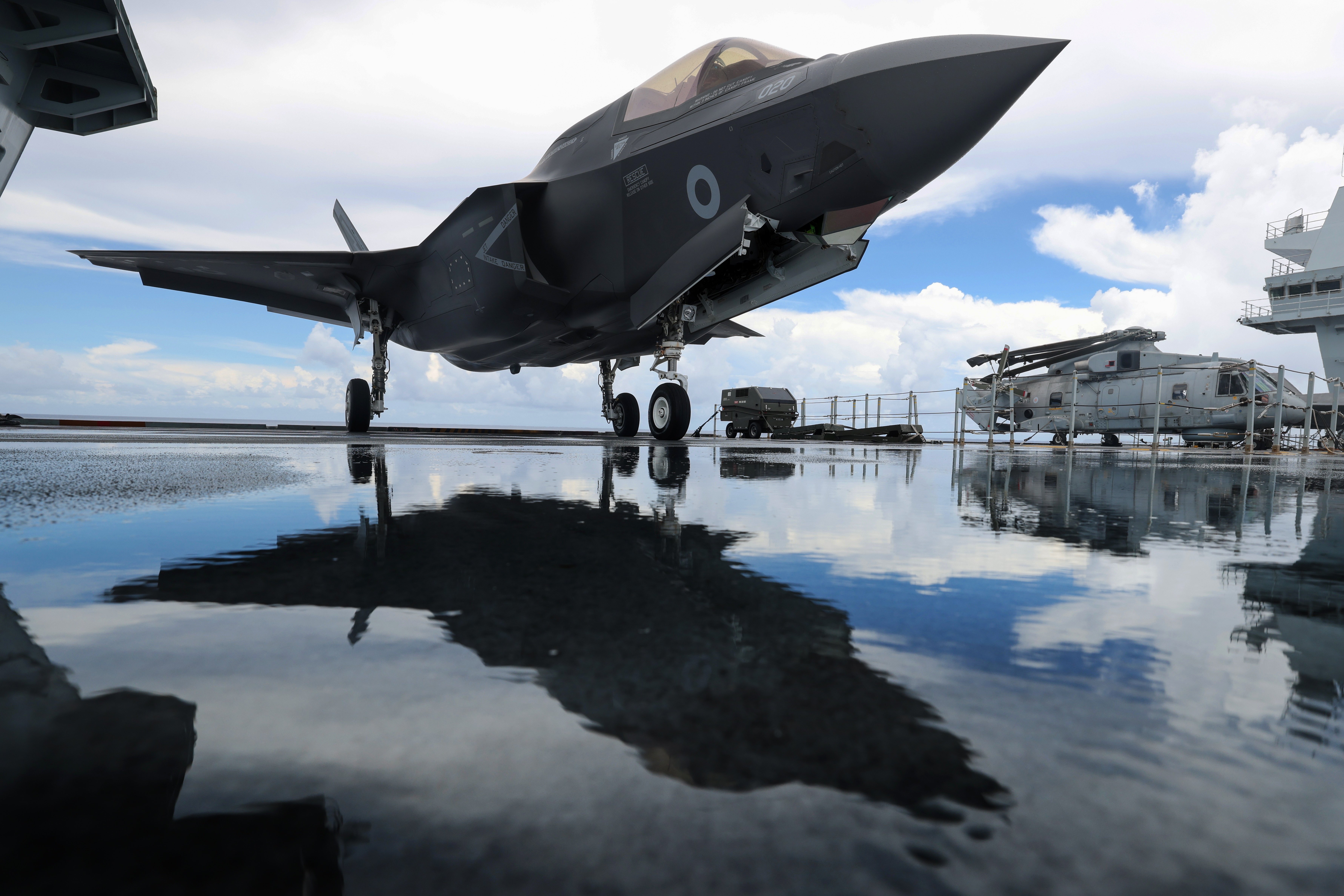
An F35B Lightning II pilot prepared to take off from HMS Queen Elizabeth (R-08) on Aug. 14, 2021. UK Royal Navy Photo
The U.K. Carrier Strike Group includes: Type 23 anti-submarine frigates HMS Richmond (F239) and HMS Kent (F78); Type 45 guided-missile destroyers HMS Defender (D36) and HMS Diamond (D34); Royal Fleet Auxiliary’s RFA Fort Victoria and RFA Tidespring; U.S. destroyer USS The Sullivans (DDG-68), Dutch frigate HNLMS Evertsen (F805); and the nuclear attack boat HMS Artful (S121). The “Wake Island Avengers” of U.S. Marine Corps Fighter Attack Squadron (VMFA) 211 are embarked and integrated with Royal Air Force 617 Squadron “The Dambusters.”
The America Amphibious Ready Group (ARG) consists of USS America (LHA-6), USS New Orleans (LPD-18) and USS Germantown (LSD-42) with the 31st Marine Expeditionary Unit embarked.
The 31st MEU is currently comprised of Marine Medium Tiltrotor Squadron (VMM) 265 (Reinforced) as the Amphibious Combat Element, Battalion Landing Team, 3rd Battalion, 5th Marines as the Ground Combat Element and Combat Logistics Battalion 31 as the Logistics Combat Element.
In the Eastern Pacific
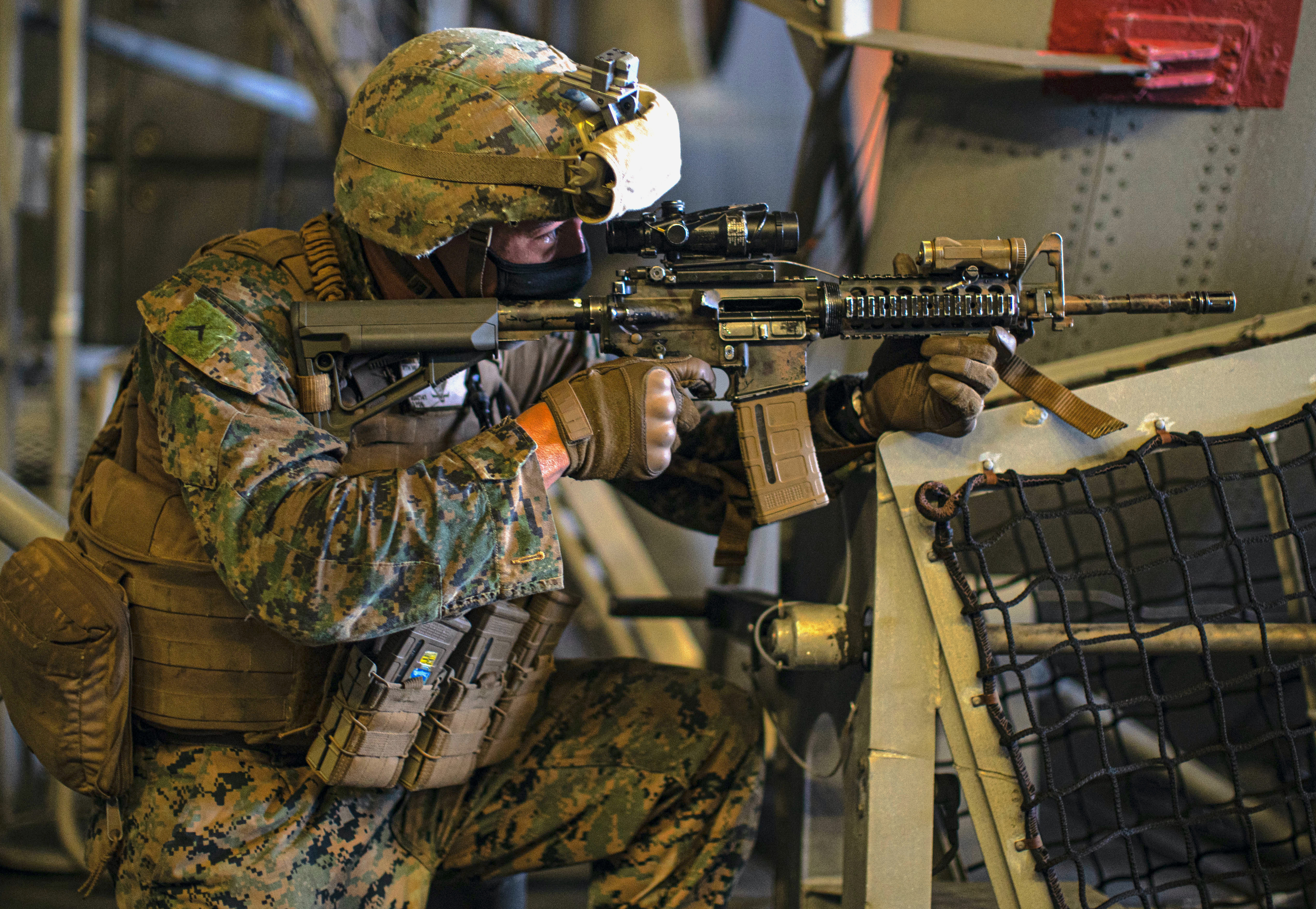
Marine Corps Pfc. David Medina, a light armored vehicle crewman with Light Armored Reconnaissance Company, Battalion Landing Team 1/1, 11th Marine Expeditionary Unit (MEU), posts security during area clearing training aboard amphibious transport dock USS Portland (LPD-27) on Aug. 20, 2021. US Marine Corps
USS Essex (LHD-2) is underway in the Eastern Pacific.
In the Western Atlantic
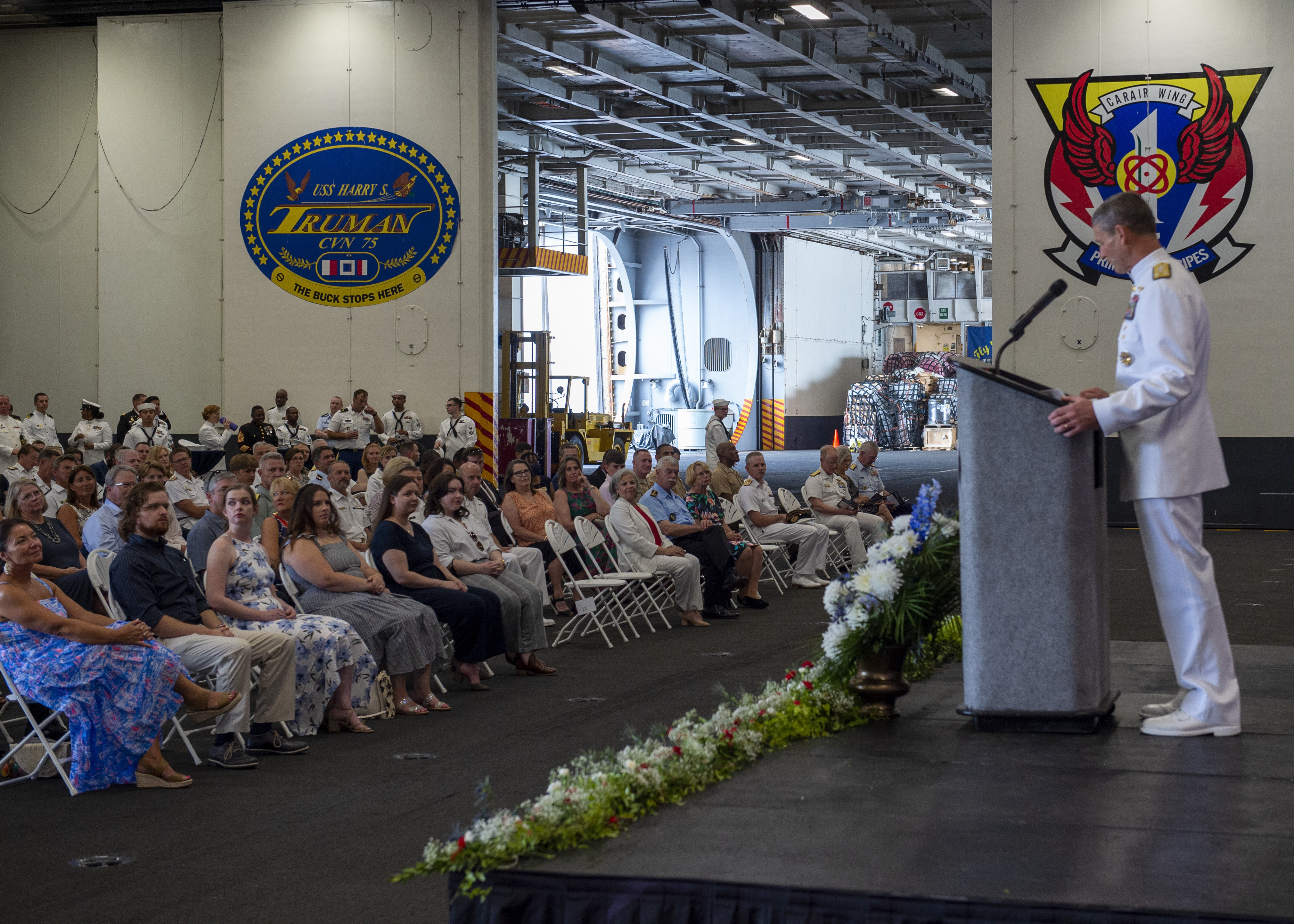
Vice Adm. Andrew Lewis speaks during his change of command ceremony aboard the aircraft carrier USS Harry S. Truman (CVN-75) on Aug. 20, 2021. US Navy Photo
USS Harry S. Truman (CVN-75) departed Naval Station Norfolk, Va., Monday morning. The Truman Carrier Strike Group is the next CSG set to deploy from the East Coast later this year. On Friday, Truman hosted the change of command for U.S. 2nd Fleet and NATO’s Joint Forces Command.
In addition to these major formations, not shown are thousands of others serving in submarines, individual surface ships, aircraft squadrons, SEALs, Special Purpose Marine Air-Ground Task Forces, Seabees, Coast Guard cutters, EOD Mobile Units, and more serving throughout the globe.











No comments:
Post a Comment
How did you like the post, leave a comment. I would appreciate hearing from you all. Best wishes from JC's Naval, Maritime and Military News